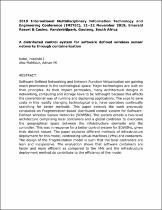 ResearchSpace
ResearchSpace
A distributed control system for software defined wireless sensor networks through containerisation
JavaScript is disabled for your browser. Some features of this site may not work without it.
- ResearchSpace
- →
- Research Publications/Outputs
- →
- Conference Publications
- →
- View Item
| dc.contributor.author |
Kobo, Hlabishi I

|
|
| dc.contributor.author |
Abu-Mahfouz, Adnan MI

|
|
| dc.date.accessioned | 2020-04-12T18:52:51Z | |
| dc.date.available | 2020-04-12T18:52:51Z | |
| dc.date.issued | 2019-11 | |
| dc.identifier.citation | Kobo, H.I. and Abu-Mahfouz, A.M.I. 2019. A distributed control system for software defined wireless sensor networks through containerisation. 2019 International Multidisciplinary Information Technology and Engineering Conference (IMITEC), 21–22 November 2019, Emerald Resort & Casino, Vanderbijlpark, Gauteng, South Africa | en_US |
| dc.identifier.isbn | 978-1-7281-0040-1 | |
| dc.identifier.isbn | 978-1-7281-0041-8 | |
| dc.identifier.uri | https://ieeexplore.ieee.org/document/9015923 | |
| dc.identifier.uri | DOI: 10.1109/IMITEC45504.2019.9015923 | |
| dc.identifier.uri | http://hdl.handle.net/10204/11414 | |
| dc.description | Copyright: 2019 IEEE. Due to copyright restrictions, the attached PDF file only contains the abstract of the full text item. For access to the full text item, please consult the publisher's website. The definitive version is published at https://ieeexplore.ieee.org/document/9015923 | en_US |
| dc.description.abstract | Software-Defined Networking and Network Function Virtualisation are gaining much prominence in the technological space. Major technologies are built on their principles. As their impact permeates, many architectural designs in networking, computing and storage have to be rethought because this affects the conventional way of running and deploying applications. The urge to save costs in this rapidly changing technological era, have operators continually searching for better methods. This paper extends the work previously conducted on Fragmentation-based distributed control system for Software-Defined Wireless Sensor Networks (SDWSN). The system entails a two-level architecture comprising local controllers and a global controller to overcome the geographical space between the infrastructure elements and the controller. This was in response for a better control system for SDWSNs, given their distinct nature. The paper explores different methods of infrastructure deployment for this model, contrasting virtual machines (VMs) and containers. The design of the Fragmentation model is such that the local controllers are lean and inexpensive. The evaluation shows that software containers are faster and more efficient as compared to the VMs and the infrastructure deployment method do contribute to the efficiency of the model. | en_US |
| dc.language.iso | en | en_US |
| dc.publisher | IEEE | en_US |
| dc.relation.ispartofseries | Worklist;23338 | |
| dc.subject | Distributed controllers | en_US |
| dc.subject | Containerisation | en_US |
| dc.subject | Fragmentation | en_US |
| dc.subject | Software-defined wireless sensor networks | en_US |
| dc.subject | SDWSNs | en_US |
| dc.subject | Virtualisation | en_US |
| dc.title | A distributed control system for software defined wireless sensor networks through containerisation | en_US |
| dc.type | Conference Presentation | en_US |
| dc.identifier.apacitation | Kobo, H. I., & Abu-Mahfouz, A. M. (2019). A distributed control system for software defined wireless sensor networks through containerisation. IEEE. http://hdl.handle.net/10204/11414 | en_ZA |
| dc.identifier.chicagocitation | Kobo, Hlabishi I, and Adnan MI Abu-Mahfouz. "A distributed control system for software defined wireless sensor networks through containerisation." (2019): http://hdl.handle.net/10204/11414 | en_ZA |
| dc.identifier.vancouvercitation | Kobo HI, Abu-Mahfouz AM, A distributed control system for software defined wireless sensor networks through containerisation; IEEE; 2019. http://hdl.handle.net/10204/11414 . | en_ZA |
| dc.identifier.ris | TY - Conference Presentation AU - Kobo, Hlabishi I AU - Abu-Mahfouz, Adnan MI AB - Software-Defined Networking and Network Function Virtualisation are gaining much prominence in the technological space. Major technologies are built on their principles. As their impact permeates, many architectural designs in networking, computing and storage have to be rethought because this affects the conventional way of running and deploying applications. The urge to save costs in this rapidly changing technological era, have operators continually searching for better methods. This paper extends the work previously conducted on Fragmentation-based distributed control system for Software-Defined Wireless Sensor Networks (SDWSN). The system entails a two-level architecture comprising local controllers and a global controller to overcome the geographical space between the infrastructure elements and the controller. This was in response for a better control system for SDWSNs, given their distinct nature. The paper explores different methods of infrastructure deployment for this model, contrasting virtual machines (VMs) and containers. The design of the Fragmentation model is such that the local controllers are lean and inexpensive. The evaluation shows that software containers are faster and more efficient as compared to the VMs and the infrastructure deployment method do contribute to the efficiency of the model. DA - 2019-11 DB - ResearchSpace DP - CSIR KW - Distributed controllers KW - Containerisation KW - Fragmentation KW - Software-defined wireless sensor networks KW - SDWSNs KW - Virtualisation LK - https://researchspace.csir.co.za PY - 2019 SM - 978-1-7281-0040-1 SM - 978-1-7281-0041-8 T1 - A distributed control system for software defined wireless sensor networks through containerisation TI - A distributed control system for software defined wireless sensor networks through containerisation UR - http://hdl.handle.net/10204/11414 ER - | en_ZA |





